
Welcome to part five of a five-part series of articles on “Emerging Stronger Post-Pandemic,” which has been specifically developed for mid-market companies. In the first article, we identified several key trends and discontinuities that have emerged from the pandemic (which smart business leaders will see as opportunities) and provided four areas that mid-market companies must focus on to not only survive, but thrive over the long-term. These four areas include:
As the world emerges from the pandemic with unprecedented change, companies are re-opening while following the health guidelines. Many are starting to think about their future and their strategic direction in the light of the emerging new normal and the uncertainty. Is it time for you to Reset Your Business Strategy? Here we present a proven, simplified five step process for rapid value creation so you can emerge even stronger from the pandemic.
- Redefining the customer experience
- Reviving your relationship with employees
- Restructuring your supply chain
- Rethinking and resetting your strategy.
The articles in this series spotlight each of these core areas.
This article presents a framework for mid-size companies to think thoughtfully about their business strategy for the future. Important questions to ask include:
- Will our strategy fit the new normal?
- What are the emerging opportunities, and how can we position ourselves to take advantage of them?
- Do we have the needed capabilities and core competences?
Almost overnight, companies have had to deal with heightened levels of uncertainty, not just with their immediate customers, but with all of their relationships. In some cases, every level of a company’s ecosystem – suppliers, distributors, customers, end users, competitors, investors, and regulatory influencers – has been impacted, causing a ripple effect. Those who are managing it well and reassessing their entire business approach will set themselves up for long-term partnerships and competitive advantage. Those who have fallen behind risk losing their share permanently and damaging their reputation.
As McKinsey noted in a recent article, one noticeable characteristic of companies that have adapted well is that they have a strong sense of identity and mission. Leaders and employees have a shared sense of purpose and a common performance culture, and they know what the company stands for beyond shareholder value, and how to get things done the right way.
A Five-Step Process
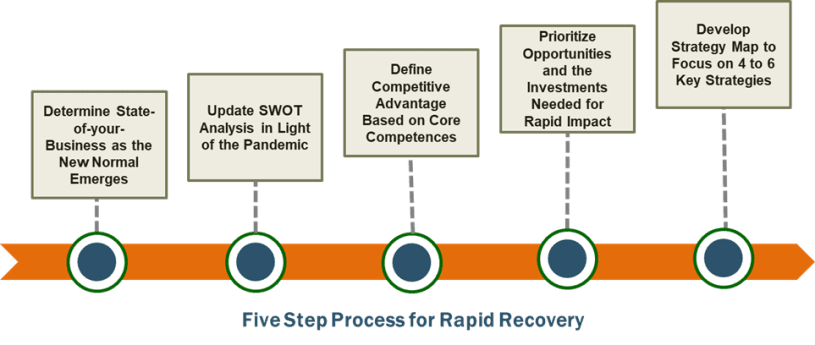
To help create that renewed sense of purpose and rethink and reset your business strategy, we’ve outlined a five-step process that will enable the rapid impact needed for companies to recover quickly. We have implemented this approach with many mid-size companies, and we continue to refine it over time.
This process will ultimately enable you to create a strategy map that summarizes your business’s refined strategic direction, which will become the rallying cry for your organization. We will show you how to:
- Determine the state-of-your-business as the new normal emerges
- Conduct a SWOT analysis in light of the pandemic
- Align your core competencies and competitive advantage with the discontinuities and major trends that have emerged
- Prioritize growth opportunities for faster impact
Want to understand if your setting yourself up to emerge strong post pandemic? Request a readiness assessment today and find out.

Step I: Determine the State-of-your-Business as the New Normal Emerge
A deeper business analysis would include
- How have profitability and margins changed?
- What is a realistic cash forecast, with sensitivity analysis? What has been the bad debt?
- What eliminated costs have to be replaced? Or new costs added?
- How have customers changed and what are the new dynamics?
- Has the supply chain been disrupted? Are some suppliers going out of business?
- Has the supply chain been disrupted? Are some suppliers going out of business?
- What are your competitors doing?
At the same time, this deeper analysis should also identify the major trends and discontinuities that have impacted your business, remembering that, as Warren Buffet said, “It is easier to ride the horse in the direction the horse is going.”
In the first post of this series, we did some of the work for you by identifying the major trends and discontinuities emerging from the pandemic. Here, you should think about the significant changes in the macro-environment that impact your specific competitive space. Do the identified discontinuities apply? Are there others impacting your business? You want to take advantage of these where you can.
Some real-life examples of significant actions companies are taking include: Apple and many other companies who are making changes to their supply chains; retailers who are investing in building online sales; the expansion of home delivery; and companies who have implemented consistent virtual meetings (among others). Very few businesses have not been affected.

Step II: Update SWOT Analysis in Light of the Pandemi
Based on the above, the second step is developing a SWOT analysis. Most companies have one, but given the tremendous change taking place, it should be updated. The business analysis and major trends/discontinuities we identified in the first article form the cornerstone for your SWOT Analysis, which can be very revealing. You can quickly hone in on strengths, weaknesses, opportunities and threats by bringing together an expanded management team. This team should include senior technical experts and commercial leaders in your company. You can add outside experts who can bring additional insight to your team.
A starting point is to have each participant in the exercise come up with their own SWOT. These can be collected and collated. In a group session, brainstorm and add to/refine the list, and the prioritize as follows:
- What are our most critical strengths versus competitors? Which strengths can be leveraged in the emerging “new normal?”
- Which weaknesses and threats need to be addressed?
- Classify opportunities as A/B/C?

Stp III: Define Competitive Advantage Based on Core Competences
We have found that this is a critical step where you clearly define, in detail, your competitive advantages. We believe that a core competencies-based approach is a very effective way of doing this, as it clearly differentiates you from the competition.
Dr. Gary Hamil and Dr. C. K. Prahlad from the London School of Economics defined core competences as functionality in your products or services that are important to customers, and are based on “What do we do as well or better than … competitors.” This integrates technical platforms, know-how (including patents), skills, processes, company values and culture to help you deliver superior value for customers. As Peter Drucker said “Don’t take on things that you yourself are not good at. Learn to say no. Effective leaders match the objective needs of their company with their subjective competencies. As a result, they get an enormous amount of things done fast.” Pursuing opportunities based on core competences will not only enable faster implementation, but will also enable more success over the longer-term, as they areas are more difficult for competition to copy.
We suggest a relatively straight forward process to define your core competences. It starts with collecting skills, capabilities, know-how, technologies, processes, etc. where you believe you are equal to or better than competitors. It determines whether these provide functionality in your products or services that are important to customers. These should be difficult for competitors to copy. A good question to ask yourself is, “Why do customers buy my products or services?” There are defined tests to determine whether a candidate is truly a core competence that can become a competitive advantage. For example, a core competence usually enables a business to charge a premium or make a higher margin.
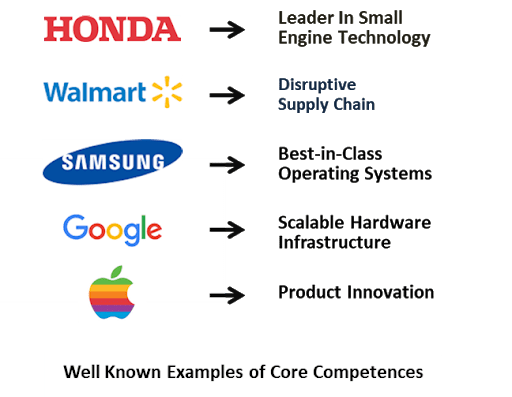

Step IV: Prioritize Opportunities and the Investments Needed for Rapid Impact
This step involves generating an opportunity list and screening these opportunities to see if they fit with your core competences and the emerging trends from COVID-19, and then prioritizing these based on size versus difficulty. The opportunity list should include (i) growth opportunities, (ii) opportunities for margin improvement through actions such as pricing, cost and supply management as well as (iii) partnerships and add-on acquisitions.
Building on the preliminary opportunities from the SWOT, we recommend additional examination and insight to develop a complete and robust opportunity list. Consider both internal and external experts to drill deeper across three areas for growth opportunities:
- Products and services
- Target customers and channels
- Geography
See the illustration for starting questions in each of these areas. Be sure to include your operations teams to examine opportunities for correcting disruptions, cost savings, and supply management.
In the opportunity list, you should include both partnerships and add-on acquisitions, especially since, unfortunately, many competitors – especially smaller ones – are unlikely to survive. This may be a faster way to get growth, enhance/add to core competences, improve your supply chain, and/or become more efficient.
The first screen for the identified opportunities is “do they fit and leverage your core competences?” This is important since growth underpinned by core competences can be achieved faster and is more sustainable since they are more difficult for competitors to copy. Plus, you want to focus on opportunities that better fit the emerging new normal and the trends and discontinuities impacting your business from COVID-19.
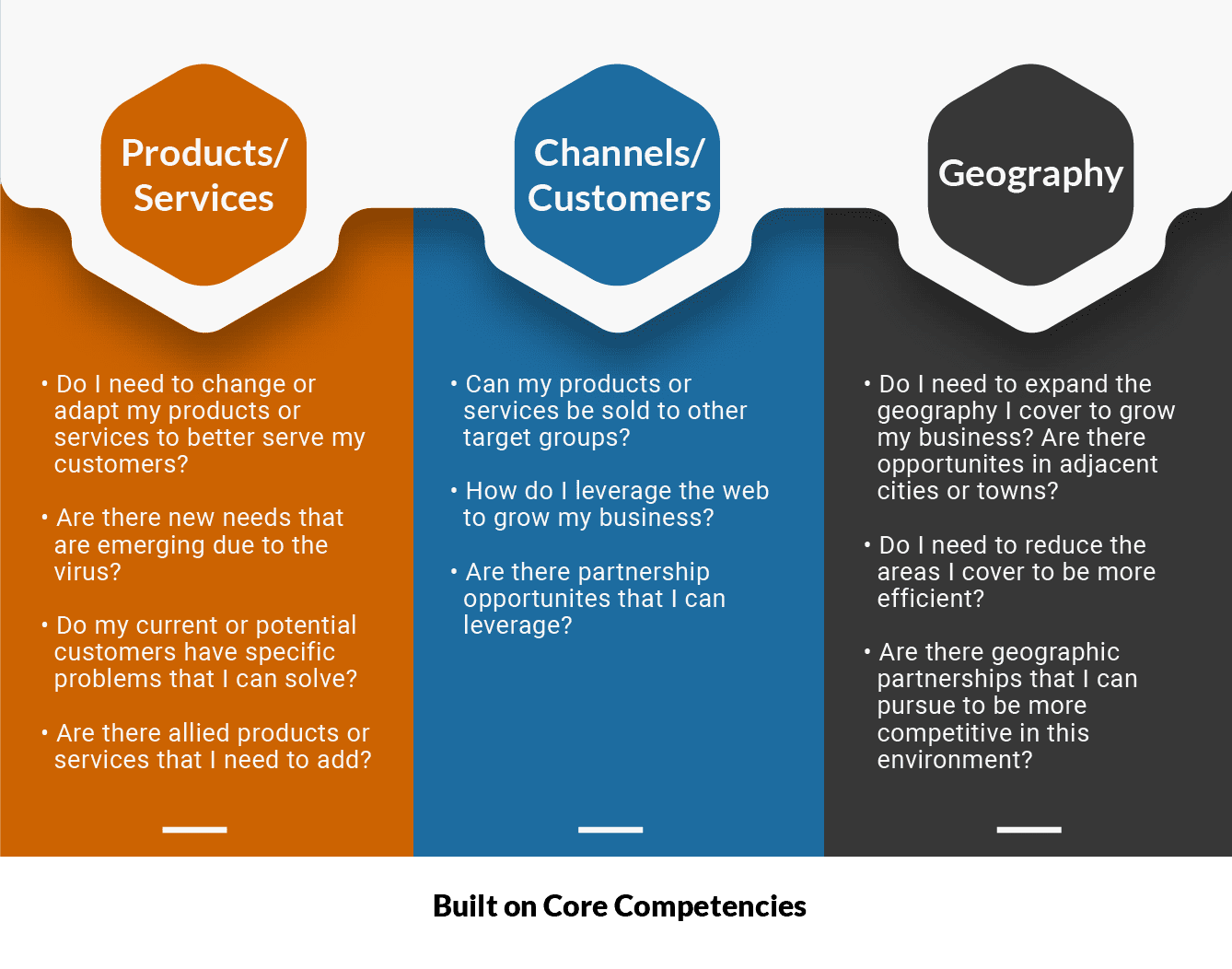
In the opportunity list, you should include both partnerships and add-on acquisitions, especially since, unfortunately, many competitors – especially smaller ones – are unlikely to survive. This may be a faster way to get growth, enhance/add to core competences, improve your supply chain, and/or become more efficient.
The first screen for the identified opportunities is “do they fit and leverage your core competences?” This is important since growth underpinned by core competences can be achieved faster and is more sustainable since they are more difficult for competitors to copy. Plus, you want to focus on opportunities that better fit the emerging new normal and the trends and discontinuities impacting your business from COVID-19.
Once you have screened for core competences as well as trends and discontinuities, we recommend prioritizing them using a 3X3 Opportunity Prioritization Matrix, based on the size of opportunity (sales/margin) and the difficulty of achieving (time needed, resources, capital, etc.). This should be tailored to your company’s specific circumstances. Focus on opportunities that are medium to high on size (sales or margins), but low to medium on difficulty of achieving. You certainly want to quickly pursue large opportunities that are relatively easy – if any emerge. This approach will have a greater and faster impact on your business. At the same time, we have found that you should expend some effort (we recommend 15% to 20% of resources) on larger opportunities that are more difficult or will take longer to achieve, choosing those that can have the greatest impact on your company’s future success.
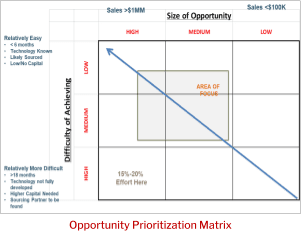
Ultimately, this approach will focus your company on opportunities that are meaningful. Plus, it enables a better allocation of usually scarce resources, as you identify the investments needed as part of the “difficulty in achieving.”

Step V: Develop Strategy Map to Focus on 4 to 6 Key Strategies
Step V: Develop Strategy Map to Focus on 4 to 6 Key Strategies
Next, develop a one-page strategy map that focuses on four to six areas that are most important to your company’s future over the next two to three years. This should clarify and summarize your strategic direction:
- Highlights the vision/mission and lays out high level financial goals
- Identifies key maneuvers, i.e. what needs to be done externally to fulfill the vision and achieve the financial goals looking at products/services, target customers/channels and geography? These are derived from the Opportunity Prioritization above.
- Identifies the key means: what are the key actions to be taken, such as investments in people and capital, new processes to be set up, added capabilities identified, etc.
- Use this to inform a strategic financial plan.
This strategy map should become a rallying cry for your company and serve as an opportunity to pull everyone in your company in the same direction toward a common goal. Within that, functions and departments can focus on what they need to do specifically to deliver on your strategy.

Examples
Based on what companies are already doing, certain directions have emerged. You should consider how these may be useful for you to consider, and how they impact your business model.
- Go contactless. Leverage the technology available, from the office and manufacturing to operations and customers.
- Be more digital, data-driven, and in the cloud. Deploy more automation and artificial intelligence to better manage operations.
- Have more variable cost structures where possible.
- Create stronger capabilities in e-commerce.
- Develop more resilient supply chains to manage future disruptions. J-I-T may now be more difficult.
- Pursue new or emerging target groups.
Some specific examples of how organizations have adapted their business models and strategies to the new realities of the pandemic include:
1: A car-rental company. With dramatic declines in sales, they found new potential target groups, such as tech firms, who were instructing employees not to use public transportation.
2: Telehealth Doctors Healthcare providers have changed their business model, which is likely to remain intact even after the pandemic ends, as patients get acclimated to this form of interaction. France, South Korea, and the U.S. have all changed regulations to ease access to telemedicine.
- Teladoc Health, the largest independent U.S. telemedicine service, is adding thousands of doctors to its network, according to the Wall Street Journal.
- Sweden’s KRY International, one of Europe’s biggest telehealth providers, noted a 200% increase in registrations.
3: Educational Organizers:They continued their mission by holding classes online and worked with students to continue to provide services. Virti, which has a virtual platform for training healthcare professionals, has already been deployed by 14,000 US healthcare professionals (through May).
In Conclusion
Ultimately, there is no universal, one-size-fits-all solution. The strategy you develop and implement should be based on your company’s unique circumstances, your environment and your competitive space. What we’ve outlined here can serve as a guide to help you through the process.
Are you ready to rethink and reset your business strategy in light of COVID-19? Let us know if you have any questions or if we can assist you in developing the right approach to customize these steps for your business. We have learned to do this in as little as three months, with limited resources.
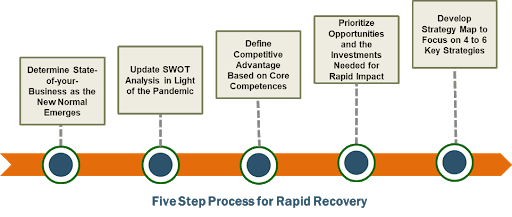
To continue to deepen relationships, ensure you’re creating content that connects. For help doing this, download our eBook
In a recent &Marketing webinar we dove deeper into the resulting business trends from COVID-19 and the necessary actions mid-market companies should take to build and sustain long-term growth. Watch the entire webinar below!
